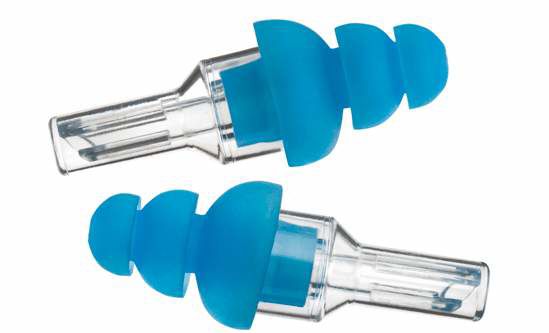These audio ‘white noise’ products are all hush-hush
Published 5:00 am Wednesday, July 20, 2011

- The Etymotic ER-20 earplugs are designed to reduce loud noise to safe levels while preserving clarity of sounds.
Before my son was born last fall, I’d always been puzzled by the idea of “white noise.” Have you seen those CDs and expensive alarm clocks (usually sold in airline catalogs) that offer the sounds of nature: waves crashing, rain drizzling, and so on? The products claim that a flat, featureless, continuous sound somehow encourages slumber. The idea seemed bizarre to me: When I sleep, I want quiet, not noise — not even the pitter-patter of angels dancing in the clouds.
But babies do like sound in order to sleep, it turns out. And so do their parents. At the baby shower last year, my wife and I received several white-noise-enabled toys; you turn over the cuddly giraffe or sheep to reveal a control panel for a variety of soothing sounds.
Trending
We’ve also each downloaded White Noise, an iPhone app that costs about $2 and has a sprawling menu of sleep-aiding noises. The app has been indispensable to our son Khalil’s sleep; with the sound on, he sleeps fitfully, but without it we have the sort of disaster that would make Jerry Bruckheimer proud.
Over the last few weeks, I have tested several other gadgets designed to help you sleep or save your ears.
Used correctly, these gadgets could change your life — you might finally get a reprieve from your snoring spouse, or vice versa; you might finally get your baby to sleep (so you can spend more time with your snoring spouse).
The most basic gadget is the Marpac Sound Screen 980A, a small beige cylinder about the size of a large salad bowl, creates white noise mechanically: It uses an internal fan and has no electronics at all. The device, which costs about $50 on Amazon, has two switches — one for a soft sound, one for a loud one — and air vents that you can adjust to change the pitch of the noise.
My wife and I found the Sound Screen’s sound to be less tinny, and thus more soothing, than that of other, cheaper white-noise devices.
What makes such white-noise devices effective? Tom Bergman, the marketing director at the Ear Plug Superstore, a site which sells a variety of noise-masking devices, said white noise works by “raising your threshold of hearing.” Your ears automatically get less acute as the level of ambient sound rises, he explained; that’s why you can’t hear a dripping faucet in the daytime, when there are many other noises, but at night, when everything’s still, the faucet becomes ear-shattering.
Trending
At the same time, because white noise does not have any recognizable variance, most people eventually don’t notice they are hearing anything at all.
Now, imagine this scenario: One half of a couple snores interminably, but can’t stand a white-noise machine. The other half can’t stand the snoring.
What should our incompatible couple do? Try foam earplugs first, Bergman suggested. The best earplugs (rated NRR 33, meaning they reduce ambient noise by 33 decibels) will provide significant relief from unwanted sound, but only if they are worn properly. “You have to roll it carefully into a thin cylinder, push it into your ear, and hold it there until it expands to fill your ear canal,” Bergman said.
For some snoring victims, though, earplugs are not enough. Enter the SnoreMasker Pro, which combines an earplug with white noise. The SnoreMasker is a hearing-aid-size earpiece that fits snugly, blocking most outside sound. But it also has a small speaker inside; as you turn the tiny volume knob on the earpiece, you hear soothing white noise, right inside your head.
I don’t have a snoring spouse, so I can’t comment on the SnoreMasker’s effectiveness. But I can say that when I inserted it and turned it on, I did feel enveloped in white noise, an entirely pleasing sensation. But it is an expensive one: Ear Plug Superstore sells the SnoreMasker Pro for $399 a pair.
Another sophisticated noise-suppression product is the “filtered earplug,” a plastic device that reduces the volume of outside sound but does not alter its character. This can be useful in many scenarios. For instance, The BlastBuster Variable Noise Reduction Shooter’s Ear Plugs, which sell for $8.75 a pair at Ear Plug Superstore, let you hear all sounds at a normal conversation level. But they block extremely loud sounds.
Another device, the Etymotic ER-20 high-fidelity earplugs, are best for listening to music: They reduce the volume of outside sound but preserve the pitch — meaning that tunes won’t sound muffled when these are in your ears. They cost about $13 a pair.
Then there’s the high-tech take on the BlastBuster concept, the Etymotic EB-15 earplugs, about $500 a pair. These plugs, which have a tiny acoustic chip, allow all quiet sounds to pass through; at low or normal levels of sound. But when the outside sound spikes (like a loud crash on a construction site), the EB-15’s sound-blocking kicks in, and your ears are saved.
And Mack’s Ear Saver, about $10, reduces the volume coming through your music player’s headphones. The Ear Saver is a small wire that sits between your player and your headphones. You plug the Ear Saver into your player, and you plug your headphones into the Ear Saver, and that’s it: no matter how high you turn the volume, you will never hear sound at a damaging level.








